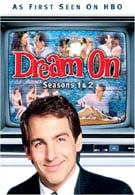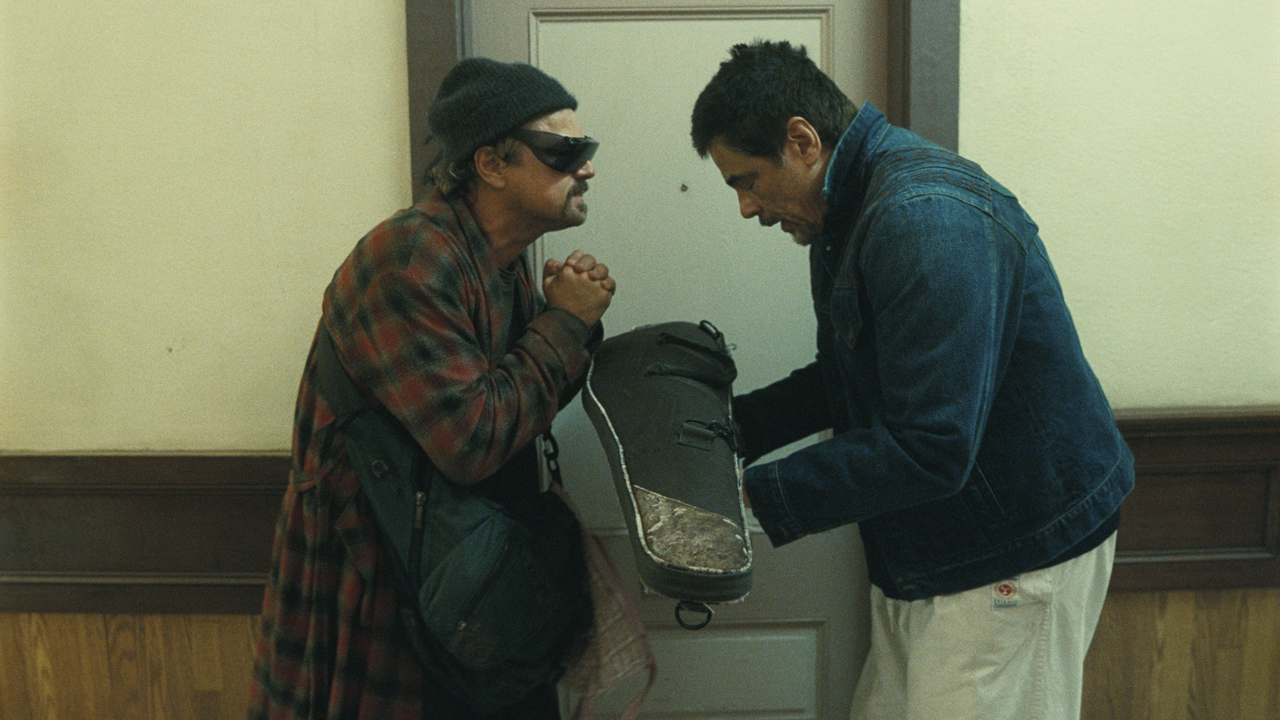I grew up in the country, where HBO and cable television were substituted by moonshining and cow tipping for entertainment. Because of that I missed out on a lot of good cable television shows, instead having to settle for the edited versions that would appear in syndication years after the show was popular. Since boobies and curse words make up a lot of the programming of HBO, is it any wonder that I hadn’t discovered “Dream On” until it’s release on DVD? Thanks to the advent of DVD, just about every show in existence has a shot at being seen again, released season by season for consumers to pick up and enjoy. Before the age of DVD though, what did you do with the leftovers? Shows that weren’t popular enough for syndication just took up room in storage facilities, making no money and costing studios space. With that in mind, Universal tasked John Landis (An American Werewolf in London) with a challenge: create a series allowing them to use older material from anthology shows that was just taking up space. Along with David Crane and Marta Kauffman, Landis came up with “Dream On”, a sitcom about life, family, and dating.
The show revolves around Martin Tupper (Brian Benben), a book editor in New York City. Martin is the everyman; he’s not incredibly handsome or of above average intelligence. In fact, Martin’s a bit of a schmuck... a Charlie Brown if you will. He’s divorced, although his ex-wife Judith (Wendie Malick) remains one of his best friends despite his jealousy over her flawless new husband Richard. Martin’s son Jeremy (Chris Demetral) is an average teenager of the ‘90s, facing that awkward new interest in girls, peer pressure about drugs, and the usual sitcom child character’s lot. Martin’s best friend is a bit of a celebrity, a womanizing host of a Geraldo-esque talk show. And then there’s Martin’s secretary Toby (Denny Dillon), a demanding bullheaded assistant that would give Murphy Brown a run for her money.
The first season of “Dream On” establishes all of the key players and even in the pilot, relationships are easy to see, as Judith pursues Martin to finalize their divorce papers and Martin starts dating (giving us the infamous whipped cream scene that catches the attention of any red blooded male who sees the advertising for the show). As the first season develops, so do the characters, particularly Richard - Judith’s perfect fiancé (and husband after Season One) who’s always helping develop a new cure or doing something else to help humanity. Although Richard is never seen, he’s the perfect foil to Martin Tupper. Richard is a superman whose exceptional deeds lead to a movie being made about his accomplishments in Season Two’s first episode. He’s a complete contrast to Martin’s everyman, who in typical sitcom fare can’t seem to keep from bungling up simple tasks. Dating a college student lands Martin in the hospital, lecturing his son on a found marijuana joint leads to Martin and Eddie toking up. While Richard would probably handle these tasks with such perfection, it wouldn’t be interesting to watch, which gives an interesting validation to us never seeing Richard - he’s only funny if we hear about his accomplishments in contrast to Martin.
While “Dream On” does resort to typical sitcom plotlines a little too frequently, it never resolves them in typical sitcom style. As mentioned before, Martin ends up enjoying the joint he finds in his son’s dresser drawer. Do you think Mr. Drummond ever would have done that? Instead of resorting to the Darren syndrome of “Bewitched”, the show has Martin’s best friend Eddie undergo plastic surgery in between seasons when actor Jeffrey Joseph was replaced with Dorien Wilson (probably my one complaint about the show - Joseph was so good establishing the slick Eddie Charles that Wilson never really lives up to the character.) It’s refreshing to see standard storylines turned upside down and, while we never would have expected it at the time, it’s easy to see now why the show was so successful in this respect with Kauffman and Crane’s names as creators (who went on to create one of network television’s most memorable comedies - “Friends”)
The other original creative liberty that adds to the success of “Dream On” is the use of older anthology footage to add a unique commentary to the show. Martin gets some bad news - cut to footage of a boxer getting pummeled. Martin gets excited in a moment of passion - cut to a train going through a tunnel, or a tree being chopped down when his excitement is interrupted. The extra footage is perfectly used to add a second voice to the show, although it’s never established whose voice it is. Is this footage in Martin’s head, something he hears or sees in his mind’s eye as events transpire? Is it just a voice we get to experience as the audience, adding a schizophrenic tone to the show? Sometimes the footage inspires Martin’s next line, and sometimes it replaces his dialog, so it’s up for debate as to why the footage is there. Although it takes a little getting used to having the story interrupted by black and white footage from old shows, it’s hilarious once you adjust to it. You also start to notice the music of the show lends itself to those old shows as well: over the top and melodramatic. It would be interesting to see more shows take advantage of this type of editing, although it’s probably best left to “Dream On” which used it perfectly, instead of letting it become the gimmick of the week.
The guest appearances are also worth mentioning. My favorite episode, the second season opener, “The Second Best Story Ever Told”, features Mimi Rogers, Stephen Furst, Tom Berenger, and David Bowie in one of the best roles ever. Other episodes feature appearances by Fran Drescher, Kathy Kinney, Larry Miller, Dan Castellaneta, Ray Walston, and Pat Paulson. As is usual for shows of this type, it’s fun to look back and see what actors appeared before they hit it big, and that’s not limited to just the “Dream On” footage. The anthology footage used features Ronald Reagan heavily, as well as Mickey Rooney, Lou Costello, Ricardo Montalban, and Jack Lemon. The whole show becomes a bit of a Who’s Who of future comedians and dramatic stars, and just when you think they’ve reached their peak as far as the regular cast and guest stars, Michael McKean starts making semi-regular appearances as Gibby, the new Australian boss of Martin’s editing firm, reminding us just how brilliant McKean can be.
Although it was big at the time, in a world where Tony Soprano and Carrie Bradshaw rule HBO’s airwaves, Martin Tupper’s life is rather tame, although you can’t help but see him as the grandparent of modern day HBO shows. Martin lives in a world of dating where nobody wears a bra, so breasts can be instantly revealed the second a shirt comes off. The whole rainbow of curse words is barely touched, although the F-bomb is dropped quite frequently. It’s almost as if “Dream On” was testing the waters to see how people would respond to its R-Rated comedy on television, setting the stage for future exposed breasts, butts, and... well, you get the idea. If you, like me, are sick and tired of HBO ripping off consumers by releasing its shows a season at a time, this DVD release will be a welcome change. Since “Dream On” was produced by Universal, not HBO, it’s not subject to HBO’s attempt to charge you large amounts of money for thirteen episodes or less. Universal wisely decided to consolidate two seasons of the series into one set, making it a little larger than the average television show, but a much better purchase than “The Sopranos” or other HBO series sets.
Your Daily Blend of Entertainment News
Unfortunately, that’s where the wisdom of the DVD release ends. The first two season’s 29 episodes are spread out among five discs, with nothing in the way of extras other than a brief introduction to the series by executive producer John Landis. That’s it. No commentary, no deleted scenes, goofs, gaffes, or anything else extra. That’s a bit of a disappointment. Considering an extra amount of planning had to go into the writing and editing process to use the anthology footage, I really would have liked to hear what it took to put an episode together. Other DVD sets from this year have proven that a decade later is a good time to look back and remember past accomplishments. It’s been over a decade since the first and second seasons of “Dream On”, but other than the intro by Landis, there’s no reflection on creating the show. That’s a real oversight by the DVD producers, hopefully an oversight that will be remedied on the remaining seasons of the show.
The DVD menus are kind of strange. The first two discs have seven episodes each, and the other discs have five episodes. However on the later disc’s episode menus, you see three episodes on the first screen with an obvious gap where a fourth episode should have been listed (as it was on the first two discs). The remaining two episodes are listed on a separate page, which just looks strange. Each episode gets a brief synopsis, which may or may not be correct. I counted at least three episodes that had absolutely nothing to do with what the disc listed as that show’s plot. While the organization is nice, the lack of accuracy and layout of those last three discs just feels sloppy.
For me, “Dream On” is a welcome discovery, and thanks to DVD I got to see the episodes uncut, as opposed to how they appear in syndication. I really found myself drawn into the show and I can’t wait for the future sets to come out and show more of Martin Tupper and the people in his life. I only hope the DVD producers decide to reveal more of what it took to make the show in the other sets.

